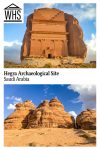Hegra Archaeological Site (al-Hijr / Madā ͐ in Ṣāliḥ)
By Soumya Gayatri
What is the Hegra Archaeological Site?
Hegra Archaeological Site, locally known as al-Hijr or Madain Salih, is an ancient Nabataean town in AlUla, Saudi Arabia. Located around 540 km (336 mi) southeast of Petra, the Nabataean capital, in Jordan, Hegra was once a prosperous trading town and a vital connecting point on the Red Sea trade route.
Hegra is home to 111 massive Nabataean rock-cut tombs from the 1st century AD. The most iconic among them is Qasr al Farid, or the Lonely Castle, which now symbolizes Hegra. These well-preserved tombs of Hegra often have beautifully decorated facades.
In Hegra, you will also see prehistoric rock art and inscriptions that tell us a lot about the people who inhabited these lands before the coming of the Nabataeans. The inscriptions are in many ancient languages, such as Thamudic, Lihyanite, Latin, and Nabataean.

Disclosure: This article contains affiliate links. Making a purchase through an affiliate link will mean a small commission for this website. This will not affect your price. Privacy policy.
Why is the Hegra Archaeological Site a UNESCO World Heritage site?
Since antiquity, Hegra was located at the crossroads of civilizations. It was an essential stop for traders on the Ancient Incense Route, connecting Asia with the Mediterranean via the Arabian Peninsula. According to UNESCO, Hegra “bears outstanding witness to important cultural exchanges in architecture, decoration, language use, and the caravan trade.”

The Archaeological Site of Hegra also holds unique evidence showcasing the Nabataean civilization’s history and culture. The UNESCO website states that the rock-cut tombs of Hegra are an “outstanding illustration of the architectural style specific to the Nabataeans. The site includes a set of wells, most of which were sunk into the rock, demonstrating the Nabataeans’ mastery of hydraulic techniques for agricultural purposes.”
What can you expect on a visit to Hegra?
When visiting Hegra in AlUla, Saudi Arabia, expect to see monumental rock-cut tombs, massive rock complexes with prehistoric inscriptions and art, and the modern reconstruction of an ancient Nabataean lady, Hinat, at the visitor’s center.
The best thing to do in Hegra is to visit Qasr al-Farid or the Lonely Castle. Qasr al-Farid is Hegra’s most famous tomb, which you always see in every AlUla poster. Dating to the 1st century, the tomb of Qasr al-Farid is about 70 feet or 21 meters tall. It was built for Lihyan, the Son of Kuza, from an elite Nabataean family. Unfortunately, the tomb was never completed, and Lihyan was never buried there!

Another set of tombs that you should absolutely visit in Hegra is Jabal Banat. Jabal Banat is a collection of 31 tombs built solely for Nabataean women. These tombs have interesting carvings of monsters, birds, and human faces. A fun way to see the tombs is by taking a hot-air balloon ride at sunrise, in which you can appreciate Hegra’s massive tombs against the stunning rocky landscape.
Another interesting place in Hegra is Jabal Ithlib, once the city’s religious center. Here, you’ll find a large ceremonial hall cut into the rock and several inscriptions telling stories about ancient gods and goddesses. Jabal Ithlib is also home to a water channel (an example of a Nabataean hydraulic system) that once fed the ancient city of Hegra.
Do not miss the Hegra Visitor’s Center, where you can see the facial reconstruction of Hinat, a Nabataean woman from the 1st century. Hinat was a powerful lady with an entire tomb dedicated to her.

Is Hegra worth visiting?
Yes, Hegra is absolutely worth visiting because it gives us rich insights into Nabataean history, architecture, and culture. Plus, Hegra’s incredible landscapes filled with stunning rock formations, known to have been created over 500 million years ago, make it a must-visit destination for nature lovers.
What sorts of travelers would like the Hegra Archaeological Site?
Travelers interested in ancient history and Nabataean architecture will love the Hegra Archaeological Site.
Tips for visiting Hegra
You can visit Hegra only on a guided tour like any of these. Visiting on your own or driving your own car through the archaeological site is not allowed.
Guided tours to Hegra usually include admission to the archaeological site, transportation in an AC bus, and the services of a knowledgeable local guide employed by the Royal Commission of AlUla. If you fancy a private tour of Hegra, check out this 3-hour tour in a vintage Land Rover.
It gets really hot in Hegra during the day. Be sure to carry your hat, sunscreen, and water.
Wear comfortable shoes because there’s a fair bit of walking on sandy and rocky trails in and around the attractions.
The best time to visit Hegra is from November to April when the weather is cool and pleasant to explore the open-air museum. This is also when several festivals are held in AlUla Old Town, such as the Ancient Kingdoms Festival, Incense Route Experience, AlUla Arts Festival, and Winter at Tantora.
Use the map below to find accommodations in AlUla:
Where is Hegra?
Hegra Archaeological Site is located in the ancient city of AlUla in the Hejaz region of Saudi Arabia. AlUla is about 620 miles (1,000 km) northwest of Riyadh and 420 miles (680 km) north of Jeddah.
AlUla International Airport is the closest to Hegra. You can take a taxi from the airport to the Old Town of AlUla or your hotel. From there, you can take a guided tour of Hegra.
For more information about the Hegra Archaeological Site, see the official website of Experience AlUla.
Have you been to Hegra? If so, do you have any additional information or advice about this UNESCO World Heritage site? Please add your comments below!


